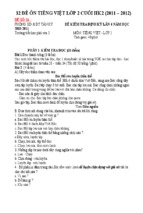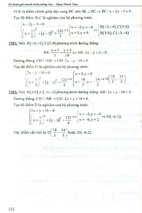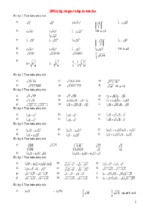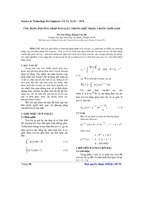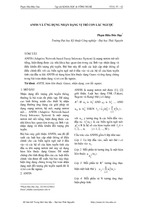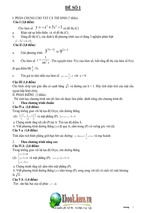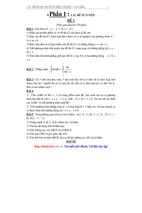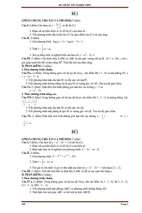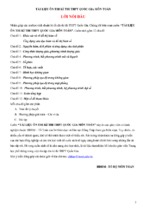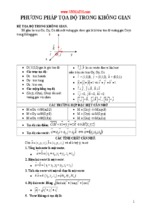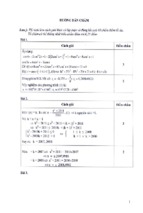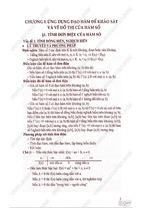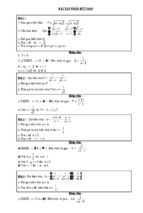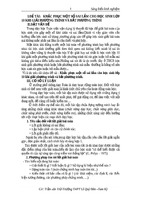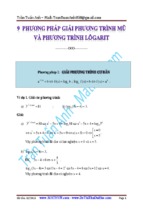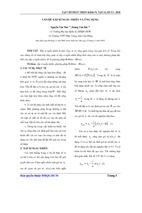MEASURE and INTEGRATION
Problems with Solutions
Anh Quang Le, Ph.D.
October 8, 2013
www.MATHVN.com - Anh Quang Le, PhD
1
NOTATIONS
A(X): The σ-algebra of subsets of X.
(X, A(X), µ) : The measure space on X.
B(X): The σ-algebra of Borel sets in a topological space X.
ML : The σ-algebra of Lebesgue measurable sets in R.
(R, ML , µL ): The Lebesgue measure space on R.
µL : The Lebesgue measure on R.
µ∗L : The Lebesgue outer measure on R.
1E or χE : The characteristic function of the set E.
www.MathVn.com - Math Vietnam
www.MATHVN.com - Anh Quang Le, PhD
2
www.MathVn.com - Math Vietnam
www.MATHVN.com - Anh Quang Le, PhD
Contents
Contents
1
1 Measure on a σ-Algebra of Sets
5
2 Lebesgue Measure on R
21
3 Measurable Functions
33
4 Convergence a.e. and Convergence in Measure
45
5 Integration of Bounded Functions on Sets of Finite Measure
53
6 Integration of Nonnegative Functions
63
7 Integration of Measurable Functions
75
8 Signed Measures and Radon-Nikodym Theorem
97
9 Differentiation and Integration
109
10 Lp Spaces
121
11 Integration on Product Measure Space
141
12 Some More Real Analysis Problems
151
www.MathVn.com3 - Math Vietnam
www.MATHVN.com - Anh Quang Le, PhD
4
CONTENTS
www.MathVn.com - Math Vietnam
www.MATHVN.com - Anh Quang Le, PhD
Chapter 1
Measure on a σ-Algebra of Sets
1. Limits of sequences of sets
Definition 1 Let (An )n∈N be a sequence of subsets of a set X.
(a) We say that (An ) is increasing if An ⊂ An+1 for all n ∈ N, and decreasing if An ⊃ An+1 for
all n ∈ N.
(b) For an increasing sequence (An ), we define
lim An :=
n→∞
∞
[
An .
n=1
For a decreasing sequence (An ), we define
lim An :=
n→∞
∞
\
An .
n=1
Definition 2 For any sequence (An ) of subsets of a set X, we define
[ \
Ak
lim inf An :=
n→∞
n∈N k≥n
lim sup An :=
n→∞
\ [
Ak .
n∈N k≥n
Proposition 1 Let (An ) be a sequence of subsets of a set X. Then
(i)
(ii)
(iii)
lim inf An = {x ∈ X : x ∈ An for all but finitely many n ∈ N}.
n→∞
lim sup An = {x ∈ X : x ∈ An for infinitely many n ∈ N}.
n→∞
lim inf An ⊂ lim sup An .
n→∞
n→∞
2. σ-algebra of sets
www.MathVn.com5 - Math Vietnam
www.MATHVN.com - Anh Quang Le, PhD
6
CHAPTER 1. MEASURE ON A σ-ALGEBRA OF SETS
Definition 3 (σ-algebra)
Let X be an arbitrary set. A collection A of subsets of X is called an algebra if it satisfies the
following conditions:
1. X ∈ A.
2. A ∈ A ⇒ Ac ∈ A.
3. A, B ∈ A ⇒ A ∪ B ∈ A.
An algebra A of a set X is called a σ-algebra if it satisfies the additional condition:
S
4. An ∈ A, ∀n ∈ N ⇒ n∈N An ∈ n ∈ N.
Definition 4 (Borel σ-algebra)
Let (X, O) be a topological space. We call the Borel σ-algebra B(X) the smallest σ-algebra of X
containing O.
It is evident that open sets and closed sets in X are Borel sets.
3. Measure on a σ-algebra
Definition 5 (Measure)
Let A be a σ-algebra of subsets of X. A set function µ defined on A is called a measure if it
satisfies the following conditions:
1. µ(E) ∈ [0, ∞] for every E ∈ A.
2. µ(∅) = 0.
3. (En )n∈N ⊂ A, disjoint ⇒ µ
¡S
n∈N
¢ P
En = n∈N µ(En ).
Notice that if E ∈ A such that µ(E) = 0, then E is called a null set. If any subset E0 of a null set
E is also a null set, then the measure space (X, A, µ) is called complete.
Proposition 2 (Properties of a measure)
A measure µ on a σ-algebra A of subsets of X has the following
properties:
Sn
Pn
(1) Finite additivity: (E1 , E2 , ..., En ) ⊂ A, disjoint =⇒ µ ( k=1 Ek ) = k=1 µ(Ek ).
(2) Monotonicity: E1 , E2 ∈ A, E1 ⊂ E2 =⇒ µ(E1 ) ≤ m(E2 ).
(3) E1 , E2 ∈ A, E1 ⊂ E2 , µ(E1 ) < ∞ =⇒ µ(E
¡S2 \ E1 ) =
¢ µ(E
P2 ) − µ(E1 ).
(4) Countable subadditivity: (En ) ⊂ A =⇒ µ n∈N En ≤ n∈N µ(En ).
Definition 6 (Finite, σ-finite measure)
Let (X, A, µ) be a measure space.
1. µ is called finite if µ(X) < ∞.
2. µ is called σ-finite if there exists a sequence (En ) of subsets of X such that
[
En and µ(En ) < ∞, ∀n ∈ N.
X=
n∈N
www.MathVn.com - Math Vietnam
www.MATHVN.com - Anh Quang Le, PhD
7
4. Outer measures
Definition 7 (Outer measure)
Let X be a set. A set function µ∗ defined on the σ-algebra P(X) of all subsets of X is called an
outer measure on X if it satisfies the following conditions:
(i) µ∗ (E) ∈ [0, ∞] for every E ∈ P(X).
(ii) µ∗ (∅) = 0.
(iii) E, F ∈ P(X), E ⊂ F ⇒ µ∗ (E) ≤ µ∗ (F ).
(iv) countable subadditivity:
Ã
(En )n∈N ⊂ P(X), µ
∗
[
n∈N
!
En
≤
X
µ∗ (En ).
n∈N
Definition 8 (Caratheodory condition)
We say that E ∈ P(X) is µ∗ -measurable if it satisfies the Caratheodory condition:
µ∗ (A) = µ∗ (A ∩ E) + µ∗ (A ∩ E c ) for every A ∈ P(X).
We write M(µ∗ ) for the collection of all µ∗ -measurable E ∈ P(X). Then M(µ∗ ) is a σ-algebra.
Proposition 3 (Properties of µ∗ )
(a) If E1 , E2 ∈ M(µ∗ ), then E1 ∪ E2 ∈ M(µ∗ ).
(b) µ∗ is additive on M(µ∗ ), that is,
E1 , E2 ∈ M(µ∗ ), E1 ∩ E2 = ∅ =⇒ µ∗ (E1 ∪ E2 ) = µ∗ (E1 ) + µ∗ (E2 ).
∗ ∗ ∗∗
www.MathVn.com - Math Vietnam
www.MATHVN.com - Anh Quang Le, PhD
8
CHAPTER 1. MEASURE ON A σ-ALGEBRA OF SETS
Problem 1
Let A be a collection of subsets of a set X with the following properties:
1. X ∈ A.
2. A, B ∈ A ⇒ A \ B ∈ A.
Show that A is an algebra.
Solution
(i) X ∈ A.
(ii) A ∈ A ⇒ Ac = X \ A ∈ A (by 2).
(iii) A, B ∈ A ⇒ A ∩ B = A \ B c ∈ A since B c ∈ A (by (ii)).
Since Ac , B c ∈ A, (A ∪ B)c = Ac ∩ B c ∈ A. Thus, A ∪ B ∈ A. ¥
Problem 2
(a) ShowSthat if (An )n∈N is an increasing sequence of algebras of subsets of a set
X, then n∈N An is an algebra of subsets of X.
(b) Show by example that even if An in (a) is a σ-algebra for every n ∈ N, the
union still may not be a σ-algebra.
Solution S
(a) Let A = n∈N An . We show that A is an algebra.
(i) Since X ∈ An , ∀n ∈ N, so X ∈ A.
(ii) Let A ∈ A. Then A ∈ An for some n. And so Ac ∈ An ( since An is an
algebra). Thus, Ac ∈ A.
(iii) Suppose A, B ∈ A. We shall show A ∪ B ∈ A.
S
Since {An } is increasing, i.e., A1 ⊂ A2 ⊂ ... and A, B ∈ n∈N An , there is
some n0 ∈ N such that A, B ∈ A0 . Thus, A ∪ B ∈ A0 . Hence, A ∪ B ∈ A.
(b) Let X = N, An = the family of all subsets of {1, 2, ...,Sn} and their complements.
Clearly, An is a σ-algebra and A1 ⊂ A2 ⊂ .... However, n∈N An is the family of all
finite and co-finite subsets of N, which is not a σ-algebra.
¥
www.MathVn.com - Math Vietnam
www.MATHVN.com - Anh Quang Le, PhD
9
Problem 3
Let X be an arbitrary infinite set. We say that a subset A of X is co-finite if its
complement Ac is a finite subset of X. Let A consists of all the finite and the
co-finite subsets of a set X.
(a) Show that A is an algebra of subsets of X.
(b) Show that A is a σ-algebra if and only if X is a finite set.
Solution
(a)
(i) X ∈ A since X is co-finite.
(ii) Let A ∈ A. If A is finite then Ac is co-finite, so Ac ∈ A. If A co-finite then Ac
is finite, so Ac ∈ A. In both cases,
A ∈ A ⇒ Ac ∈ A.
(iii) Let A, B ∈ A. We shall show A ∪ B ∈ A.
If A and B are finite, then A ∪ B is finite, so A ∪ B ∈ A. Otherwise, assume
that A is co-finite, then A ∪ B is co-finite, so A ∪ B ∈ A. In both cases,
A, B ∈ A ⇒ A ∪ B ∈ A.
(b) If X is finite then A = P(X), which is a σ-algebra.
To show the reserve, i.e., if A is a σ-algebra then X is finite, we assume that X
is infinite. So we can find an infinite sequence (a1 , a2 , ...) of distinct elements of X
such that
S X \ {a1 , a2 , ...} is infinite. Let An = {anS}. Then An ∈ A for any n ∈ N,
while n∈N An is neither finite nor co-finite. So n∈N An ∈
/ A. Thus, A is not a
σ-algebra: a contradiction!
¥
Note:
For an arbitrary collection C of subsets of a set X, we write σ(C) for the smallest
σ-algebra of subsets of X containing C and call it the σ-algebra generated by C.
Problem 4
Let C be an arbitrary collection of subsets of a set X. Show that for a given
A ∈ σ(C), there exists a countable sub-collection CA of C depending on A such
that A ∈ σ(CA ). (We say that every member of σ(C) is countable generated).
www.MathVn.com - Math Vietnam
www.MATHVN.com - Anh Quang Le, PhD
10
CHAPTER 1. MEASURE ON A σ-ALGEBRA OF SETS
Solution
Denote by B the family of all subsets A of X for which there exists a countable
sub-collection CA of C such that A ∈ σ(CA ). We claim that B is a σ-algebra and
that C ⊂ B.
The second claim is clear, since A ∈ σ({A}) for any A ∈ C. To prove the first one,
we have to verify that B satisfies the definition of a σ-algebra.
(i) Clearly, X ∈ B.
(ii) If A ∈ B then A ∈ σ(CA ) for some countable family CA ⊂ σ(C). Then
Ac ∈ σ(CA ), so Ac ∈ B.
(iii) Suppose S
{An }n∈N ⊂ B. Then An ∈ σ(CAn ) for some countable family CAn ⊂ C.
Let E = n∈N CAn then E isS
countable and E ⊂ C andSAn ∈ σ(E) for all n ∈ N.
By definition of σ-algebra, n∈N An ∈ σ(E), and so n∈N An ∈ B.
Thus, B is a σ-algebra of subsets of X and E ⊂ B. Hence,
σ(E) ⊂ B.
By definition of B, this implies that for every A ∈ σ(C) there exists a countable
E ⊂ C such that A ∈ σ(E). ¥
Problem 5
Let γ a set function defined on a σ-algebra A of subsets of X. Show that it γ is
additive and countably subadditive on A, then it is countably additive on A.
Solution
We first show that the additivity of γ implies its monotonicity. Indeed, let A, B ∈ A
with A ⊂ B. Then
B = A ∪ (B \ A) and A ∩ (B \ A) = ∅.
Since γ is additive, we get
γ(B) = γ(A) + γ(B \ A) ≥ γ(A).
Now let (En ) be a disjoint sequence in A. For every N ∈ N, by the monotonicity
and the additivity of γ, we have
Ã
!
ÃN
!
N
[
[
X
γ
En ≥ γ
En =
γ(En ).
n∈N
n=1
n=1
www.MathVn.com - Math Vietnam
www.MATHVN.com - Anh Quang Le, PhD
11
Since this holds for every N ∈ N, so we have
Ã
!
[
X
(i) γ
En ≥
γ(En ).
n∈N
n∈N
On the other hand, by the countable subadditivity of γ, we have
Ã
!
X
[
γ(En ).
(ii) γ
En ≤
n∈N
n∈N
From (i) and (ii), it follows that
Ã
γ
[
!
En
=
n∈N
This proves the countable additivity of γ.
X
γ(En ).
n∈N
¥
Problem 6
Let X be an infinite set and A be the algebra consisting of the finite and co-finite
subsets of X (cf. Prob.3). Define a set function µ on A by setting for every
A ∈ A:
½
0
if A is finite
µ(A) =
1 if A is co-finite.
(a) Show that µ is additive.
(b) Show that when X is countably infinite, µ is not additive.
(c) Show that when X is countably infinite, then X is the limit of an increasing
sequence {An : n ∈ N} in A with µ(An ) = 0 for every n ∈ N, but µ(X) = 1.
(d) Show that when X is uncountably, the µ is countably additive.
Solution
(a) Suppose A, B ∈ A and A ∩ B = ∅ (i.e., A ⊂ B c and B ⊂ Ac ).
If A is co-finite then B is finite (since B ⊂ Ac ). So A ∪ B is co-finite. We have
µ(A ∪ B) = 1, µ(A) = 1 and µ(B) = 0. Hence, µ(A ∪ B) = µ(A) + µ(B).
If B is co-finite then A is finite (since A ⊂ B c ). So A ∪ B is co-finite, and we have
the same result. Thus, µ is additive.
(b) Suppose X is countably infinite. We can then put X under this form: X =
{x1 , x2 , ...}, xi 6= xj if i 6= j. Let AP
n = {xn }. Then the family {An }n∈N is disjoint
and µ(An ) = 0 for every n ∈ N. So n∈N µ(An ) = 0. On the other hand, we have
www.MathVn.com - Math Vietnam
www.MATHVN.com - Anh Quang Le, PhD
12
S
n∈N
CHAPTER 1. MEASURE ON A σ-ALGEBRA OF SETS
An = X, and µ(X) = 1. Thus,
Ã
!
[
X
µ
An 6=
µ(An ).
n∈N
n∈N
Hence, µ is not additive.
(c) Suppose X is countably infinite, and X = {x1 , x2 , ...}, xi 6= xj if i 6= j as in
(b). Let Bn = {x1 , x2 , ..., xn }. Then µ(Bn ) = 0 for every n ∈ N, and the sequence
(Bn )n∈N is increasing. Moreover,
[
Bn = X and µ(X) = 1.
lim Bn =
n→∞
n∈N
(d) Suppose XS is uncountably. Consider the family of disjoint sets {Cn }n∈N in A.
Suppose C = n∈N Cn ∈ A. We first claim: At most one of the Cn ’s can be co-finite.
Indeed, assume there are two elements Cn and Cm of the family are co-finite. Since
Cm ⊂ Cnc , so Cm must be finite: a contradiction.
Suppose Cn0 is the co-finite set. Then since C ⊃ Cn0 , C is also co-finite. Therefore,
Ã
!
[
µ(C) = µ
Cn = 1.
n∈N
On the other hand, we have
µ(Cn0 ) = 1 and µ(Cn ) = 0 for n 6= n0 .
Thus,
Ã
µ
If all Cn are finite then
[
n∈N
S
!
Cn
=
X
µ(Cn ).
n∈N
Cn is finite, so we have
Ã
!
[
X
0=µ
Cn =
µ(Cn ).
n∈N
n∈N
¥
n∈N
Problem 7
Let (X, A, µ) be a measure space. Show that for any A, B ∈ A, we have the
equality:
µ(A ∪ B) + µ(A ∩ B) = µ(A) + µ(B).
www.MathVn.com - Math Vietnam
www.MATHVN.com - Anh Quang Le, PhD
13
Solution
If µ(A) = ∞ or µ(B) = ∞, then the equality is clear. Suppose µ(A) and µ(B) are
finite. We have
A ∪ B = (A \ B) ∪ (A ∩ B) ∪ (B \ A),
A = (A \ B) ∪ (A ∩ B)
B = (B \ A) ∪ (A ∩ B).
Notice that in these decompositions, sets are disjoint. So we have
(1.1)
(1.2)
µ(A ∪ B) = µ(A \ B) + µ(A ∩ B) + µ(B \ A),
µ(A) + µ(B) = 2µ(A ∩ B) + µ(A \ B) + µ(B \ A).
From (1.1) and (1.2) we obtain
µ(A ∪ B) − µ(A) − µ(B) = −µ(A ∩ B).
The equality is proved.
¥
Problem 8
The symmetry difference of A, B ∈ P(X) is defined by
A 4 B = (A \ B) ∪ (B \ A).
(a) Prove that
∀A, B, C ∈ P(X), A 4 B ⊂ (A 4 C) ∪ (C 4 B).
(b) Let (X, A, µ) be a measure space. Show that
∀A, B, C ∈ A, µ(A 4 B) ≤ µ(A 4 C) + µ(C 4 B).
Solution
(a) Let x ∈ A 4 B. Suppose x ∈ A \ B. If x ∈ C then x ∈ C \ B so x ∈ C 4 B. If
x∈
/ C, then x ∈ A \ C, so x ∈ A 4 C. In both cases, we have
x ∈ A 4 B ⇒ x ∈ (A 4 C) ∪ (C 4 B).
The case x ∈ B \ A is dealt with the same way.
(b) Use subadditivity of µ and (a).
¥
www.MathVn.com - Math Vietnam
www.MATHVN.com - Anh Quang Le, PhD
14
CHAPTER 1. MEASURE ON A σ-ALGEBRA OF SETS
Problem 9
Let X be an infinite set and µ the counting measure on the σ-algebra A = P(X).
Show that there exists a decreasing sequence (En )n∈N in A such that
lim En = ∅ with
n→∞
lim µ(En ) 6= 0.
n→∞
Solution
Since X is a infinite set, we can find an countably infinite set {x1 , x2 , ...} ⊂ X with
xi 6= xj if i 6= j. Let En = {xn , xn+1 , ...}. Then (En )n∈N is a decreasing sequence in
A with
lim En = ∅ and lim µ(En ) = 0. ¥
n→∞
n→∞
Problem 10 (Monotone sequence of measurable sets)
Let (X, A, µ) be a measure space, and (En ) be a monotone sequence in A.
(a) If (En ) is increasing, show that
¡
¢
lim µ(En ) = µ lim En .
n→∞
n→∞
(b) If (En ) is decreasing, show that
¡
¢
lim µ(En ) = µ lim En ,
n→∞
n→∞
provided that there is a set A ∈ A satisfying µ(A) < ∞ and A ⊃ E1 .
Solution
S
Recall that if (En ) is increasing
then
lim
E
=
n→∞
n
n∈N En ∈ A, and if (En ) is
T
decreasing then limn→∞
E
=
E
∈
A.
Note
also
that if (En ) is a monotone
n¢
n∈N n
¡
sequence in A, then µ(En ) is a monotone sequence in [0, ∞] by the monotonicity
of µ, so that limn→∞ µ(En ) exists in [0, ∞].
¡
¢
(a) Suppose (En ) is increasing. Then the sequence µ(En ) is also increasing.
Consider the first case where µ(En0 ) = ∞ for some En0 . In this case we have
limn→∞ µ(En ) = ∞. On the other hand,
En0 ⊂
[
n∈N
¢
¡
En = lim En =⇒ µ lim En ≥ µ(En0 ) = ∞.
n→∞
n→∞
www.MathVn.com - Math Vietnam
www.MATHVN.com - Anh Quang Le, PhD
15
Thus
¡
¢
µ lim En = ∞ = lim µ(En ).
n→∞
n→∞
Consider the next case where µ(En ) < ∞ for all n ∈ N. Let E0 = ∅, then consider
the disjoint sequence (Fn ) in A defined by Fn = En \En−1 for all n ∈ N. It is evident
that
[
[
En =
Fn .
n∈N
n∈N
Then we have
¡
Ã
¢
µ lim En = µ
n→∞
[
!
En
Ã
= µ
n∈N
=
X
[
!
Fn
n∈N
µ(Fn ) =
n∈N
=
X£
X
µ(En \ En−1 )
n∈N
µ(En ) − µ(En−1 )
¤
n∈N
=
=
lim
n→∞
n
X
£
¤
µ(Ek ) − µ(Ek−1 )
£k=1
¤
lim µ(En ) − µ(E0 ) = lim µ(En ).
n→∞
n→∞
¤
(b) Suppose (En ) is decreasing and assume the existence of a containing set A with
finite measure. Define a disjoint sequence (Gn ) in A by setting Gn = En \ En+1 for
all n ∈ N. We claim that
\
[
(1) E1 \
En =
Gn .
n∈N
n∈N
T
T
To show this, let x ∈ E1 \ n∈N En . Then x ∈ E1 and x ∈
/ n∈N En . Since the
sequence (En ) is decreasing, there exists the first set En0 +1 in the sequence not
containing x. Then
[
x ∈ En0 \ En0 +1 = Gn0 =⇒ x ∈
Gn .
n∈N
S
Conversely, if x ∈ n∈N Gn , then x ∈ Gn0 = ET
N. Now
n0 \ En0 +1 for some n0 ∈ T
x ∈ En0 ⊂ E1 . Since x ∈
/ En0 +1 , we have x ∈
/ n∈N En . Thus x ∈ E1 \ n∈N En .
Hence (1) is proved.
Now by (1) we have
Ã
!
Ã
!
\
[
(2) µ E1 \
En = µ
Gn .
n∈N
n∈N
www.MathVn.com - Math Vietnam
www.MATHVN.com - Anh Quang Le, PhD
16
Since µ
CHAPTER 1. MEASURE ON A σ-ALGEBRA OF SETS
¡T
¢
E
≤ µ(E1 ) ≤ µ(A) < ∞, we have
n
n∈N
Ã
!
Ã
!
\
\
(3) µ E1 \
En
= µ(E1 ) − µ
En
n∈N
n∈N
= µ(E1 ) − µ( lim En ).
n→∞
By the countable additivity of µ, we have
Ã
!
[
X
X
(4) µ
Gn
=
µ(Gn ) =
µ(En \ En+1 )
n∈N
n∈N
=
X£
n∈N
¤
µ(En ) − µ(En+1 )
n∈N
=
=
lim
n
X
£
n→∞
¤
µ(Ek ) − µ(Ek+1 )
£k=1
¤
lim µ(E1 ) − µ(En+1 )
n→∞
= µ(E1 ) − lim µ(En+1 ).
n→∞
Substituting (3) and (4) in (2), we have
µ(E1 ) − µ( lim En ) = µ(E1 ) − lim µ(En+1 ).
n→∞
n→∞
Since µ(E1 ) < ∞, we have
µ( lim En ) = lim µ(En ).
n→∞
n→∞
¥
www.MathVn.com - Math Vietnam
www.MATHVN.com - Anh Quang Le, PhD
17
Problem 11 (Fatou’s lemma for µ)
Let (X, A, µ) be a measure space, and (En ) be a sequence in A.
(a) Show that
¡
¢
µ lim inf En ≤ lim inf µ(En ).
n→∞
n→∞
(b) If there exists A ∈ A with En ⊂ A and µ(A) < ∞ for every n ∈ N, then
show that
¡
¢
µ lim sup En ≥ lim sup µ(En ).
n→∞
n→∞
Solution
(a) Recall that
[ \
lim inf En =
n→∞
by the fact that
we have
(∗)
¡T
k≥n
Ek
n→∞
n∈N k≥n
¢
n∈N
¡
Ek = lim
\
Ek ,
k≥n
is an increasing sequence in A. Then by Problem 9a
Ã
¢
µ lim inf En = lim µ
n→∞
n→∞
\
!
Ek
Ã
= lim inf µ
n→∞
k≥n
\
!
Ek
,
k≥n
since the
is ¢equal to the limit inferior of the sequence.
T limit of a sequence, if it ¡exists,
T
Since k≥n Ek ⊂ En , we have µ k≥n Ek ≤ µ(En ) for every n ∈ N. This implies
that
!
Ã
\
Ek ≤ lim inf µ(En ).
lim inf µ
n→∞
n→∞
k≥n
Thus by (∗) we obtain
¡
¢
µ lim inf En ≤ lim inf µ(En ).
n→∞
n→∞
(b) Now
lim sup En =
n→∞
\ [
Ek = lim
n→∞
n∈N k≥n
[
Ek ,
k≥n
¡S
¢
by the fact that
Ek n∈N is an decreasing sequence in A. Since En ⊂ A for all
k≥n
S
n ∈ N, we have k≥n Ek ⊂ A for all n ∈ N. Thus by Problem 9b we have
¢
¡
µ lim sup En = µ
n→∞
Ã
lim
n→∞
[
k≥n
!
Ek
Ã
= lim µ
n→∞
[
k≥n
www.MathVn.com - Math Vietnam
!
Ek
.
www.MATHVN.com - Anh Quang Le, PhD
18
CHAPTER 1. MEASURE ON A σ-ALGEBRA OF SETS
Now
Ã
lim µ
n→∞
[
!
Ek
Ã
= lim sup µ
n→∞
k≥n
[
!
Ek
,
k≥n
since the S
limit of a sequence, if it exists, is equal to the limit superior of the sequence.
Then by k≥n Ek ⊃ En we have
Ã
!
[
µ
Ek ≥ µ(En ).
k≥n
Thus
Ã
lim sup µ
n→∞
It follows that
[
!
Ek
≥ lim sup µ(En ).
n→∞
k≥n
¡
¢
µ lim sup En ≥ lim sup µ(En ).
n→∞
¥
n→∞
Problem 12
Let µ∗ be an outer measure on a set X. Show that the following two conditions
are equivalent:
(i) µ∗ is additive on P(X).
(ii) Every element of P(X) is µ∗ -measurable, that is, M(µ∗ ) = P(X).
Solution
• Suppose µ∗ is additive on P(X). Let E ∈ P(X). Then for any A ∈ P(X),
A = (A ∩ E) ∪ (A ∩ E c ) and (A ∩ E) ∩ (A ∩ E c ) = ∅.
By the additivity of µ∗ on P(X), we have
µ∗ (A) = µ∗ (A ∩ E) + µ∗ (A ∩ E c ).
This show that E satisfies the Carathéodory condition. Hence E ∈ M(µ∗ ). So
P(X) ⊂ M(µ∗ ). But by definition, M(µ∗ ) ⊂ P(X). Thus
M(µ∗ ) = P(X).
• Conversely, suppose M(µ∗ ) = P(X). Since µ∗ is additive on M(µ∗ ) by Proposition 3, so µ∗ is additive on P(X).
¥
www.MathVn.com - Math Vietnam
www.MATHVN.com - Anh Quang Le, PhD
19
Problem 13
Let µ∗ be an outer measure on a set X.
(a) Show that the restriction µ of µ∗ on the σ-algebra M(µ∗ ) is a measure on
M(µ∗ ).
(b) Show that if µ∗ is additive on P(X), then it is countably additive on P(X).
Solution
(a) By definition, µ∗ is countably subadditive on P(X). Its restriction µ on M(µ∗ )
is countably subadditive on M(µ∗ ). By Proposition 3b, µ∗ is additive on M(µ∗ ).
Therefore, by Problem 5, µ∗ is countably additive on M(µ∗ ). Thus, µ∗ is a measure
on M(µ∗ ). But µ is the restriction of µ∗ on M(µ∗ ), so we can say that µ is a
measure on M(µ∗ ).
(b) If µ∗ is additive on P(X), then by Problem 11, M(µ∗ ) = P(X). So µ∗ is a
measure on P(X) (Problem 5). In particular, µ∗ is countably additive on P(X). ¥
www.MathVn.com - Math Vietnam
- Xem thêm -

